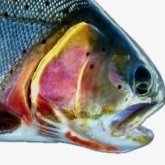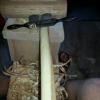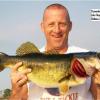-
Content Count
2,406 -
Joined
-
Last visited
Community Reputation
0 NeutralAbout Capt Bob LeMay
-
Rank
Advanced Member
Previous Fields
-
Favorite Species
Everything that swims in the 'Glades
-
Security
22
Contact Methods
-
Website URL
http://
-
ICQ
0
Profile Information
-
Location
south Florida
Recent Profile Visitors
20,736 profile views
-

Has anyone "wired" flies?
Capt Bob LeMay replied to megsdad's topic in Fly Fishing Gear & Techniques
Saltwater to the rescue... I use #3 Malin's stainless coffee colored trolling wire.... Here's a pic... Most tackle shops that cater to saltwater anglers stock Malins... this wire leader material comes in various sizes - this is the one of the lighter ones. You'll have to learn the haywire twist to use it properly. I've recently begun to use "tippet rings" instead of a swivel or Albright knot to secure my leader to the wire bite tippet. The usual advice is to keep any wire leader short (only three or four inches worth) so that your leader has the least bad effects on the streamer fly you're using. That does not apply when sharks are your targets (and I'd never use very light wire, like size #3 for shark setups at all...). -

(No fly zone) Non fly caught fish pictures
Capt Bob LeMay replied to caloosa bug's topic in The Lodge
Winds... howling and yowling (must be springtime down here in paradise, the wind's been blowning for a few weeks now...) but still lots of bookings... A day or two ago I had two anglers from the San Diego area on board using plugcasting (or occasionally spinning gear). That day the tarpon were hiding, but we still caught lots of speckled trout and other species - then carefully released them. At the end of the day this nice snook gave us fits after biting a leadhead with plastic tail - in a jungle of downed trees... With a little luck we un-snagged the fish and this was the result - a nice snook for a quick photo... Earlier that day he also caught and released his first goliath grouper... Now, if only the winds would ease off a bit... -
That's a problem we all have to deal with... Imagine a wholesaler with a barrel of feathers to process (with all that entails...), package and sell -only that container has "bugs".... and so it goes
-
This time of year we stay booked up and have little time for fishing reports - so this will be a short one. I made time, a night or two ago, to do some exploring up at Jupiter (for those not from this area - it's just north of the Palm Beaches..). I deliberately went on a tide that I normally don't fish to learn whether it would be productive - and it was.... After dark now - you need to be a bit cautious since they're building a massive new bridge with lots of big barges and cranes - but they do have temporary navigation lights that make it do-able... and at a docklight I'd never fished before (the very first one I checked...) there were lots of small snook in the lights chasing any baitfish or shrimp that the tide presented. Using a 9wt fly rod my first cast got hammered by a small snook - here's a quick photo before it was carefully released... this young snook ate a Night Fly that is normally meant for tarpon then went racing back towards the dock before coming to hand A cast or two later - that same fly got another workout - with a bit bigger fish... and a lot tougher fight... then carefully released Although I was supposed to be exploring - I couldn't resist trying for one more fish -using that same chewed up fly - and this time the next fish was bigger still... this one might have been slot sized - but was released to fight another day... I was very tempted to stay right where I was since the snook were in a feeding mood - but still needed to do the exploring I came for.... The next two hours I checked docklights I knew and a few that I'd never taken a close look at with great results. Without picking up a rod you could see fish at most of the lights I checked -some of them big girls (the kind that take you to school up under the nearest dock if hook one..). Pretty sure that any night trip up to Jupiter will be well worth doing in the coming months to add to the night trips locally in nearby Biscayne Bay... Enough for now - will be down at Flamingo today... Like I mentioned we're busy this time of year.... " Be a hero... take a kid fishing" Tight lines Bob LeMay (954) 435-5666
-
Here's a step by step one of the ways I do "clousers" (most I know consider that to be a tying style as opposed to a specific pattern...). This particular version, on a 2/0 Mustad 34007 hook, is a standard for working shorelines in the backcountry of the Everglades - we also use it in freshwater when the fish are larger and aggressive -but in brighter colors (see April patterns) and in different sizes... but at one time or another we use "clousers" as small as size #2 and as large as 3/0 depending on what forage is present... This fly is almost foul-proof and the wire weedguard allows an angler to toss his bug into the bushes and actually slide it back out without snagging up (very handy in my area... this version was named for Whitewater Bay where it gets a lot of use...). Note.... the wire size is dependent on hook size - for hooks 1/0 and larger -#5 wire, for hooks #2 and #1 we use #4 wire... Hook: Mustad 34007 2/0 Eyes: large beadchain (the same size as the pull cord on vertical blinds.... Thread : Danville's flat waxed (or equivalent in 210 denier...), fl Fire orange, fl. green Body: double course of orange tying thread (also used to secure eyes..) Wing: white bucktail twice the hook's length, with fl. green bucktail over (after adding flash...) Flash: pearl Flashabou between white and green wing... Weedguard: Malin's trolling wire, coffee colored #5 Finish: none, after tying and before wire is bent into position, thin superglue on head (Krazy Glue) Start thread one beadchain width behind hook eye, do a double course to hookpoint then back, figure eight eyes into position... tie off.. this pic shows the weedguards ready to use - they'll be tied in by the hairpin end and remain sticking out as the fly is completed (you might need a band-aid or two learning to use them....) Reverse hook to ride point up, change thread to fl. green then tie in weedguard by the bend pointing straight forward as shown. Learning to complete the pattern with that wire sticking out... might require a couple of band-aids until you get the hang of it.. first part of the wing tied in place, then 6 strands of pearl flashabou is wound around the barrel of your bobbin and slid into place on top of the white bucktail (strands have staggered ends..). the fiinal fl. green bucktail is tied in on top of the white, then the head is completed, whip finished and tied off. Now raise the wire a bit (to get it away from the hook eye - then coat the head lightly with thin super glue.. Once the super glue dries bend weedguard into place then trim it at the hook's barb and do a small final bend and you're done.
-
One of my anglers asked about the patterns we're using for peacock bass locally - here's a sampling ranging from as small as a #2 - all the way up to a 2/0 for the "clousers".. The small maribou fly is a Crystal Schminnow in size #4... most in my area consider that a clouser is more of a tying style than a specific pattern... I have a tying sequence that I'll post separately...
-
I was one of those vets who came home in 1971 - when we snuck back into the country and did everything possible to avoid wearing the uniform... The current fashion of thanking young folks for their service is a far cry from that era. Not a bad thing at all - but it's not what we experienced at all. I suspect that most of us simply got on with our lives, keeping a low profile. To this day I don't belong to any veteran's groups although I was an Army brat and grew up all over the world before I went in the service myself in 1968. My Dad was a career type and did two tours in Vietnam in '65 and '69 before retiring in 1970...
-
Our night trips... are never in jungle areas at all (after a lot of years you learn where not to fish..). Instead we're fishing the urban areas (between Miami and Miami Beach in Biscayne bay - or up at Jupiter...) where we're pretty much bug free. All of our night stuff revolves around docklights or in the shadows up under a bridge somewhere. The night scene for us is all about sight-fishing and we're looking at every fish we encounter, mostly... You have to stand off of docklights but in bridge shadows we're working so close to small (20 to 40lb tarpon mostly) that you can almost reach out and touch one with your rod... It was the very first thing I was introduced to - in 1972.... and I'd been doing the night scene for a lot of years before I took up guiding.
-
Love that brutal winter weather ... it causes my phone to ring down here in paradise where we get all covered up when the weather is below 70 degrees... On the other end of the scale - when summer comes around I don't get too many bookings to fish the 'glades at all... even though the fishing gets better and better all summer long (while the actual jungle conditions get worse and worse...). Thank heavens for night trips.
-
Not sure if I've mentioned this before... several of my wholesalers have mentioned that covid really messed up some of their local supply sources for things like bucktails, squirrel tails, etc. and that they've been having great difficulty obtaining commercial quantities of natural furs/ tails... Hope this is just a temporary situation. I'd advise anyone to buy those kinds of materials at your local shop these days (if possible) so that you can get a hands on evaluation of exactly what you're buying... Wish it weren't so...
-
This time of year everything's biting in the 'glades... This snook was caught and released with an 8wt rod and new streamer we've been using.... That fly took at least 20 fish that day.... Tail: old yellowed polar bear Hook: Owner Aki light in size #1 Body: synthetic Body Fur in fl. yellow Eyes: Wapsi presentation lead eyes Weedguard: #4 trolling wire (Malin's stainless, coffee colored. Note... during my years filling fly orders for shops and anyone else who knew what they wanted.. I never used any of my small supply of polar bear for a single fly... Years later, as the hair is almost no longer usable I'm beginning to use a bit of it here or there...
-
Most of the time I'm a wholesale operator and doing my orders by phone... When there's something on my shopping list that's a critical item (needed to fill an order I'm working on, or needed for my guiding work) I've learned to request a call back after they've pulled the order to find out then if what I need is out of stock, so I can look elsewhere instead of waiting to find out when I receive my goods a few days later (or a week or two later in a few cases... If I have the slightest doubt that they'll call me back I'll make a point of getting the individual's contact info while placing my order and do a call back myself... before the end of their working day to verify that what I'm needing is (or isn't) in that order when it's shipped... This routine, of course, was learned the hard way.... Over the years I've learned that an occasional supplier was not reliable in one way or another - that business was off of my list to purchase from the moment they let me down... Matter of fact I've just found my very first defective fly line in nearly fifty years of fly fishing - after only two days usage and will be contacting the manufacturer directly later on today. Their response will tell me whether I'll be using their lines in the future. I try to keep at least one spare new line for every line size from a 5wt up to a 12wt on hand (in some cases, 8, 9 and 10wt lines - two spares...). The backcountry of the Everglades, all mangrove jungle shorelines... is very hard on fly lines and my floating lines rarely last more than one year for my anglers... Note... Very pleased, that line manufacturer stepped up, requested I send in the line so they could examine it - and will send a replacement.. .They'll be getting more orders from this corner...
-
We're nearly over-run with juvenile goliath grouper in the backcountry (interior) of the Everglades and nearby areas these days. By juveniles - I mean fish less than fifty pounds. They've been fully protected now for nearly thirty years and as a direct result they've been allowed to increase in population to the point that they're displacing other species... Here's my latest example - a seven pound specimen taken in less than two feet of water while trying to catch a redfish or snook instead... a great catch on an 8wt rod using a Seaducer pattern - but in a very shallow interior shoreline where you'd never expect to see one at all.. Kind of a mixed blessing I guess - but one more example of why my state needs to re-consider its protected status... tougher than an old leather boot and quite aggressive - they're the baddest fish in the 'glades - now if there were just not so many of them... Of course, like always - this specimen was carefully caught and released...






